Strategic Service Vision Report: Silver Spoon Hotel, Australia
VerifiedAdded on 2022/11/23
|11
|3322
|401
Report
AI Summary
This report provides a comprehensive analysis of service management strategies for the Silver Spoon Hotel, a hotel and restaurant in Australia. It begins with an executive summary and introduction that highlights the importance of service management in the tourism and hospitality industry, emphasizing the need to balance quality and productivity. The report then delves into the hotel's operating strategy, focusing on ways to maintain this balance through employee training, goal setting, gradual implementation of changes, employee empowerment, and the use of technology. A detailed service blueprint is presented, outlining key customer touchpoints and potential fail points, with a focus on timely service and after-sale services. The service delivery system is examined, considering both tangible and intangible aspects of service, as well as the importance of customization. The report also addresses service employee management, emphasizing the link between employee satisfaction and customer experience, and suggesting strategies to enhance employee motivation and reduce turnover. Finally, the report discusses quality management measures and the application of a service quality model to the hotel's operations.
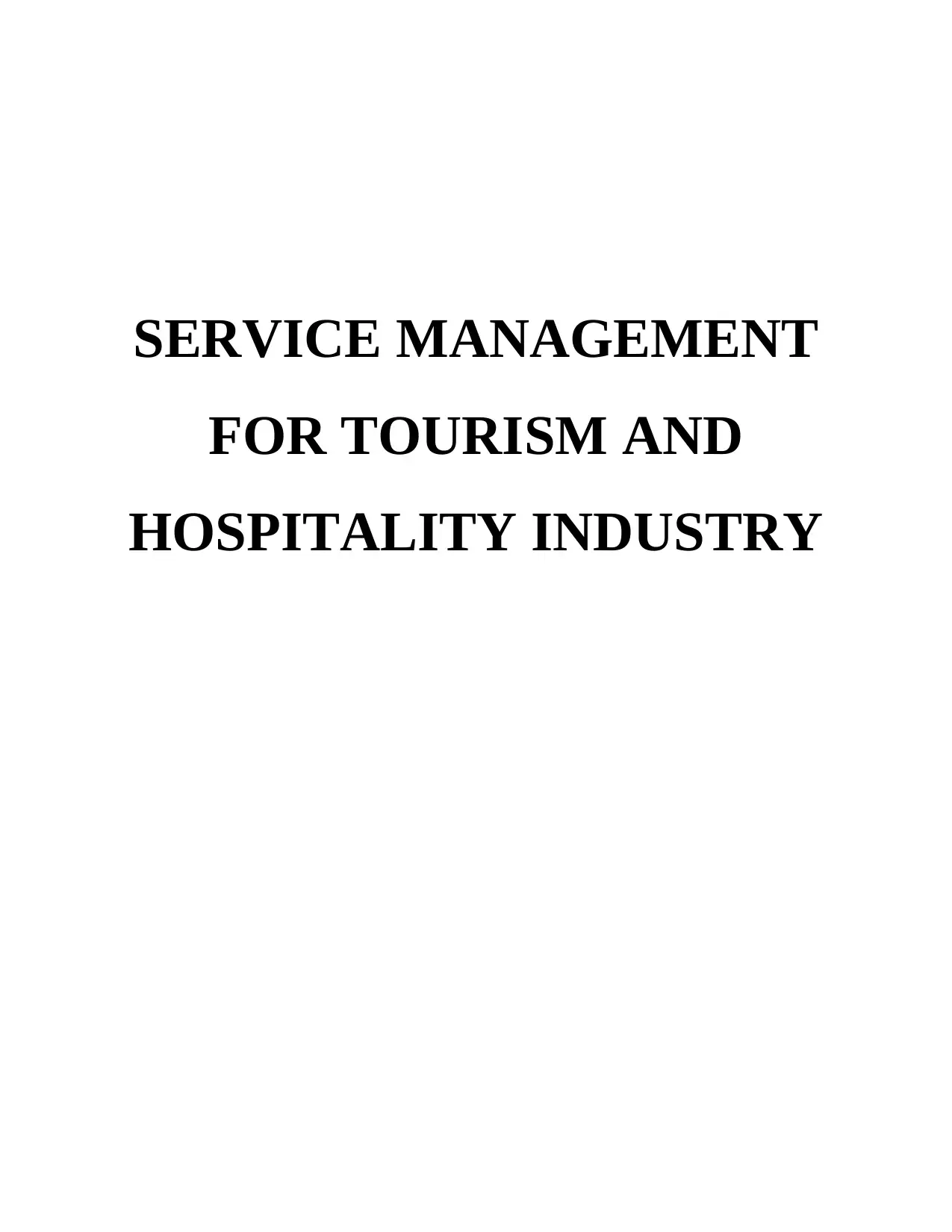
SERVICE MANAGEMENT
FOR TOURISM AND
HOSPITALITY INDUSTRY
FOR TOURISM AND
HOSPITALITY INDUSTRY
Paraphrase This Document
Need a fresh take? Get an instant paraphrase of this document with our AI Paraphraser
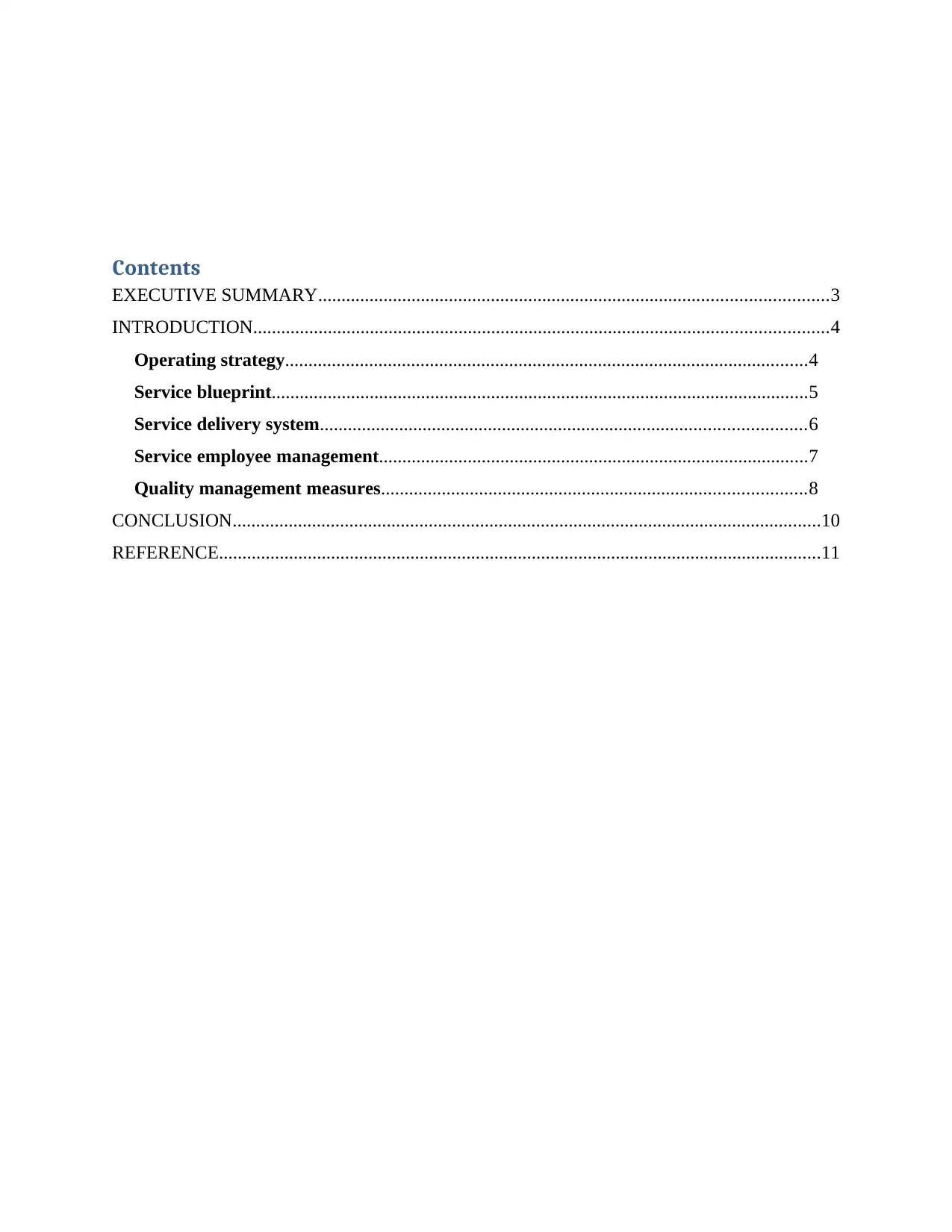
Contents
EXECUTIVE SUMMARY.............................................................................................................3
INTRODUCTION...........................................................................................................................4
Operating strategy................................................................................................................4
Service blueprint...................................................................................................................5
Service delivery system........................................................................................................6
Service employee management............................................................................................7
Quality management measures...........................................................................................8
CONCLUSION..............................................................................................................................10
REFERENCE.................................................................................................................................11
EXECUTIVE SUMMARY.............................................................................................................3
INTRODUCTION...........................................................................................................................4
Operating strategy................................................................................................................4
Service blueprint...................................................................................................................5
Service delivery system........................................................................................................6
Service employee management............................................................................................7
Quality management measures...........................................................................................8
CONCLUSION..............................................................................................................................10
REFERENCE.................................................................................................................................11
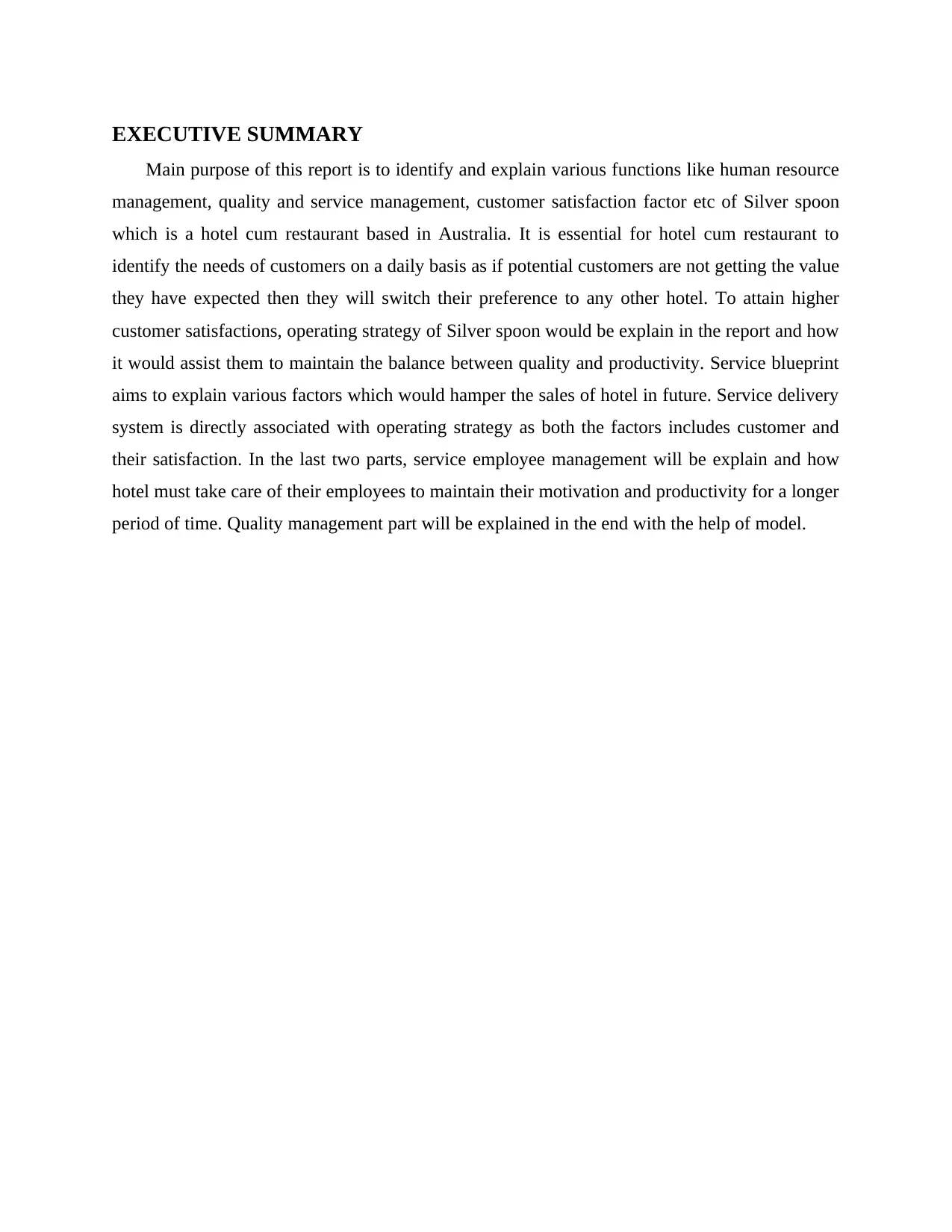
EXECUTIVE SUMMARY
Main purpose of this report is to identify and explain various functions like human resource
management, quality and service management, customer satisfaction factor etc of Silver spoon
which is a hotel cum restaurant based in Australia. It is essential for hotel cum restaurant to
identify the needs of customers on a daily basis as if potential customers are not getting the value
they have expected then they will switch their preference to any other hotel. To attain higher
customer satisfactions, operating strategy of Silver spoon would be explain in the report and how
it would assist them to maintain the balance between quality and productivity. Service blueprint
aims to explain various factors which would hamper the sales of hotel in future. Service delivery
system is directly associated with operating strategy as both the factors includes customer and
their satisfaction. In the last two parts, service employee management will be explain and how
hotel must take care of their employees to maintain their motivation and productivity for a longer
period of time. Quality management part will be explained in the end with the help of model.
Main purpose of this report is to identify and explain various functions like human resource
management, quality and service management, customer satisfaction factor etc of Silver spoon
which is a hotel cum restaurant based in Australia. It is essential for hotel cum restaurant to
identify the needs of customers on a daily basis as if potential customers are not getting the value
they have expected then they will switch their preference to any other hotel. To attain higher
customer satisfactions, operating strategy of Silver spoon would be explain in the report and how
it would assist them to maintain the balance between quality and productivity. Service blueprint
aims to explain various factors which would hamper the sales of hotel in future. Service delivery
system is directly associated with operating strategy as both the factors includes customer and
their satisfaction. In the last two parts, service employee management will be explain and how
hotel must take care of their employees to maintain their motivation and productivity for a longer
period of time. Quality management part will be explained in the end with the help of model.
⊘ This is a preview!⊘
Do you want full access?
Subscribe today to unlock all pages.

Trusted by 1+ million students worldwide

INTRODUCTION
Tourism and hospitality industry is growing day by day because people are travelling
between different countries for various purposes like leisure, vacation, businesses, education, etc
(Maglio & et. al., 2018). This has placed importance of increasing and providing varied services
to the customers. For this purpose, service management is considered to be one of the crucial
aspects. Organisation undertaken for this report is Silver spoon which is a hotel cum restaurant
situated in Australia. This report will concentrate on devising the manner in which company will
make balance between the quality while maximising the productivity of the products. One of the
blueprints for the service will be done. It will also put focus on examining the methods which are
required to manage the quality. Last part of the report will concentrate on emphasising quality of
service received by external customers. And explanation of service quality model will be done.
Operating strategy
The operating strategy which must be taken into account by the Silver Spoon so that they can
concentrate on maintaining the balance between the quality of services by maximising the level
of productivity (Grönroos, 2017). It is very important to provide products of superior quality in
the hospitality industry because customers are highly concerned about the superiority and
features provided by the organisation. Furthermore, this helps in gaining competitive advantage.
The following are some of the ways which must be taken into account and it is discussed below:
Providing training to the employees: Employees are the most valuable assets of the
business organisation. The company must concentrate on identifying the different
training needs and requirements of the employees. Accordingly, different training
sessions must be organised which will not only improve the potential and learning ability
of the employees but will also encourage them to work towards the attainment of
business goals and objectives effectively and efficiently.
Establishing goals regarding quality and productivity: The business enterprise or
hotel must focus towards developing objectives and goals which relates to the quality and
productivity. This will help in building focus of workers towards the respective goals
where they will be aware of what needs to be achieved. These goals must be specific,
measurable, accessible, reliable and time bound such that the workers will try to
Tourism and hospitality industry is growing day by day because people are travelling
between different countries for various purposes like leisure, vacation, businesses, education, etc
(Maglio & et. al., 2018). This has placed importance of increasing and providing varied services
to the customers. For this purpose, service management is considered to be one of the crucial
aspects. Organisation undertaken for this report is Silver spoon which is a hotel cum restaurant
situated in Australia. This report will concentrate on devising the manner in which company will
make balance between the quality while maximising the productivity of the products. One of the
blueprints for the service will be done. It will also put focus on examining the methods which are
required to manage the quality. Last part of the report will concentrate on emphasising quality of
service received by external customers. And explanation of service quality model will be done.
Operating strategy
The operating strategy which must be taken into account by the Silver Spoon so that they can
concentrate on maintaining the balance between the quality of services by maximising the level
of productivity (Grönroos, 2017). It is very important to provide products of superior quality in
the hospitality industry because customers are highly concerned about the superiority and
features provided by the organisation. Furthermore, this helps in gaining competitive advantage.
The following are some of the ways which must be taken into account and it is discussed below:
Providing training to the employees: Employees are the most valuable assets of the
business organisation. The company must concentrate on identifying the different
training needs and requirements of the employees. Accordingly, different training
sessions must be organised which will not only improve the potential and learning ability
of the employees but will also encourage them to work towards the attainment of
business goals and objectives effectively and efficiently.
Establishing goals regarding quality and productivity: The business enterprise or
hotel must focus towards developing objectives and goals which relates to the quality and
productivity. This will help in building focus of workers towards the respective goals
where they will be aware of what needs to be achieved. These goals must be specific,
measurable, accessible, reliable and time bound such that the workers will try to
Paraphrase This Document
Need a fresh take? Get an instant paraphrase of this document with our AI Paraphraser

minimise the errors and defects in order to maintain the quality and maximise the
productivity levels.
Implementation of changes slowly: If the current process or style of working in Silver
spoon needs to be changed then this change must implemented step by step. This is
because if whole process is changes in one go then employees of the hotel may get
frustrated. It needs time to get adjust to the working style as the employees normally
resist changes (Gibson & Parkman, 2018). Furthermore, if whole changes take place
significantly then this will also affect the quality and productivity may be decreased so
for this purpose also it is important to execute changes slowly and step wise.
Empowering and motivating workers: Employees are the ones who are responsible to
meet the business goals and objectives (Davis & et. al., 2018). They are continuously
involved in the production processes of the services so they must be encouraged to
provide some suggestions and ideas in order to enhance the improvement and must
provides recommendations through which procedure can be improved. It will helps in
adopting different means and ways through which Silver Spoon can minimise the defects
and errors and maintains the level of productivity. This will also help in attaining
competitive advantage at the marketplace.
Use of innovative and advanced technology: The technology is emerging in the global
market at rapid rate. Silver spoon must take into account the use of different innovative
and advanced technologies which not only makes the work process simpler but also
enhances the higher quality products with effective productivity levels. Each and every
company is involved in making use of technology because it also helps in generating new
and innovative products. Also the labour work becomes simpler and errors can be easily
detected in the products which are associated with technical equipments.
Service blueprint
Service blueprint is considered to be the technique through which organisations like Silver
Spoon can concentrate on designing the unique, exclusive and innovative products and services
for their customers (Kandampully, Zhang & Jaakkola, 2018). This is prepared on the process
chart which is done by taking into different views, perceptions and perspectives of the customers.
There are various points which can be taken as a service blueprint from the customers view point
while delivering process of services and they are discussed below:
productivity levels.
Implementation of changes slowly: If the current process or style of working in Silver
spoon needs to be changed then this change must implemented step by step. This is
because if whole process is changes in one go then employees of the hotel may get
frustrated. It needs time to get adjust to the working style as the employees normally
resist changes (Gibson & Parkman, 2018). Furthermore, if whole changes take place
significantly then this will also affect the quality and productivity may be decreased so
for this purpose also it is important to execute changes slowly and step wise.
Empowering and motivating workers: Employees are the ones who are responsible to
meet the business goals and objectives (Davis & et. al., 2018). They are continuously
involved in the production processes of the services so they must be encouraged to
provide some suggestions and ideas in order to enhance the improvement and must
provides recommendations through which procedure can be improved. It will helps in
adopting different means and ways through which Silver Spoon can minimise the defects
and errors and maintains the level of productivity. This will also help in attaining
competitive advantage at the marketplace.
Use of innovative and advanced technology: The technology is emerging in the global
market at rapid rate. Silver spoon must take into account the use of different innovative
and advanced technologies which not only makes the work process simpler but also
enhances the higher quality products with effective productivity levels. Each and every
company is involved in making use of technology because it also helps in generating new
and innovative products. Also the labour work becomes simpler and errors can be easily
detected in the products which are associated with technical equipments.
Service blueprint
Service blueprint is considered to be the technique through which organisations like Silver
Spoon can concentrate on designing the unique, exclusive and innovative products and services
for their customers (Kandampully, Zhang & Jaakkola, 2018). This is prepared on the process
chart which is done by taking into different views, perceptions and perspectives of the customers.
There are various points which can be taken as a service blueprint from the customers view point
while delivering process of services and they are discussed below:
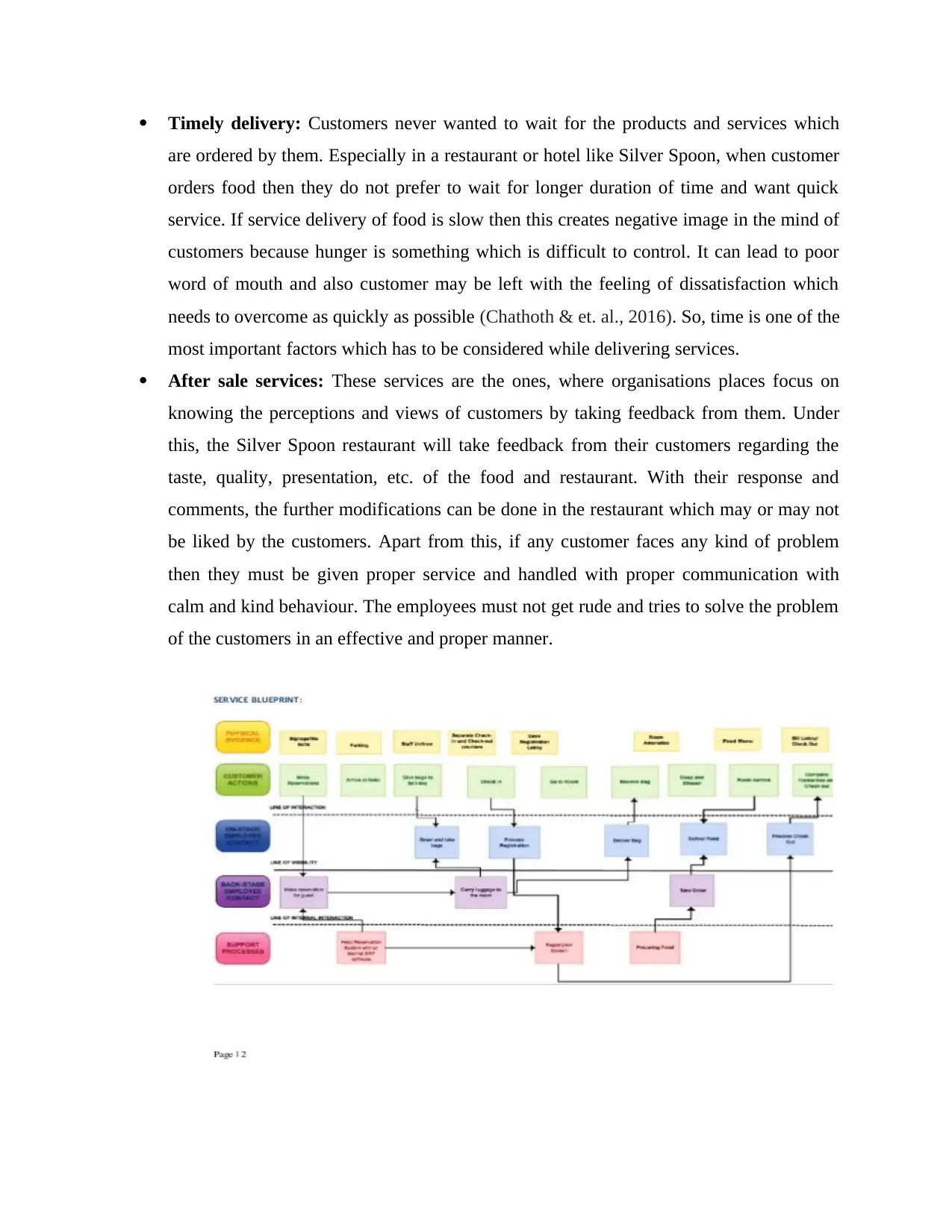
Timely delivery: Customers never wanted to wait for the products and services which
are ordered by them. Especially in a restaurant or hotel like Silver Spoon, when customer
orders food then they do not prefer to wait for longer duration of time and want quick
service. If service delivery of food is slow then this creates negative image in the mind of
customers because hunger is something which is difficult to control. It can lead to poor
word of mouth and also customer may be left with the feeling of dissatisfaction which
needs to overcome as quickly as possible (Chathoth & et. al., 2016). So, time is one of the
most important factors which has to be considered while delivering services.
After sale services: These services are the ones, where organisations places focus on
knowing the perceptions and views of customers by taking feedback from them. Under
this, the Silver Spoon restaurant will take feedback from their customers regarding the
taste, quality, presentation, etc. of the food and restaurant. With their response and
comments, the further modifications can be done in the restaurant which may or may not
be liked by the customers. Apart from this, if any customer faces any kind of problem
then they must be given proper service and handled with proper communication with
calm and kind behaviour. The employees must not get rude and tries to solve the problem
of the customers in an effective and proper manner.
are ordered by them. Especially in a restaurant or hotel like Silver Spoon, when customer
orders food then they do not prefer to wait for longer duration of time and want quick
service. If service delivery of food is slow then this creates negative image in the mind of
customers because hunger is something which is difficult to control. It can lead to poor
word of mouth and also customer may be left with the feeling of dissatisfaction which
needs to overcome as quickly as possible (Chathoth & et. al., 2016). So, time is one of the
most important factors which has to be considered while delivering services.
After sale services: These services are the ones, where organisations places focus on
knowing the perceptions and views of customers by taking feedback from them. Under
this, the Silver Spoon restaurant will take feedback from their customers regarding the
taste, quality, presentation, etc. of the food and restaurant. With their response and
comments, the further modifications can be done in the restaurant which may or may not
be liked by the customers. Apart from this, if any customer faces any kind of problem
then they must be given proper service and handled with proper communication with
calm and kind behaviour. The employees must not get rude and tries to solve the problem
of the customers in an effective and proper manner.
⊘ This is a preview!⊘
Do you want full access?
Subscribe today to unlock all pages.

Trusted by 1+ million students worldwide
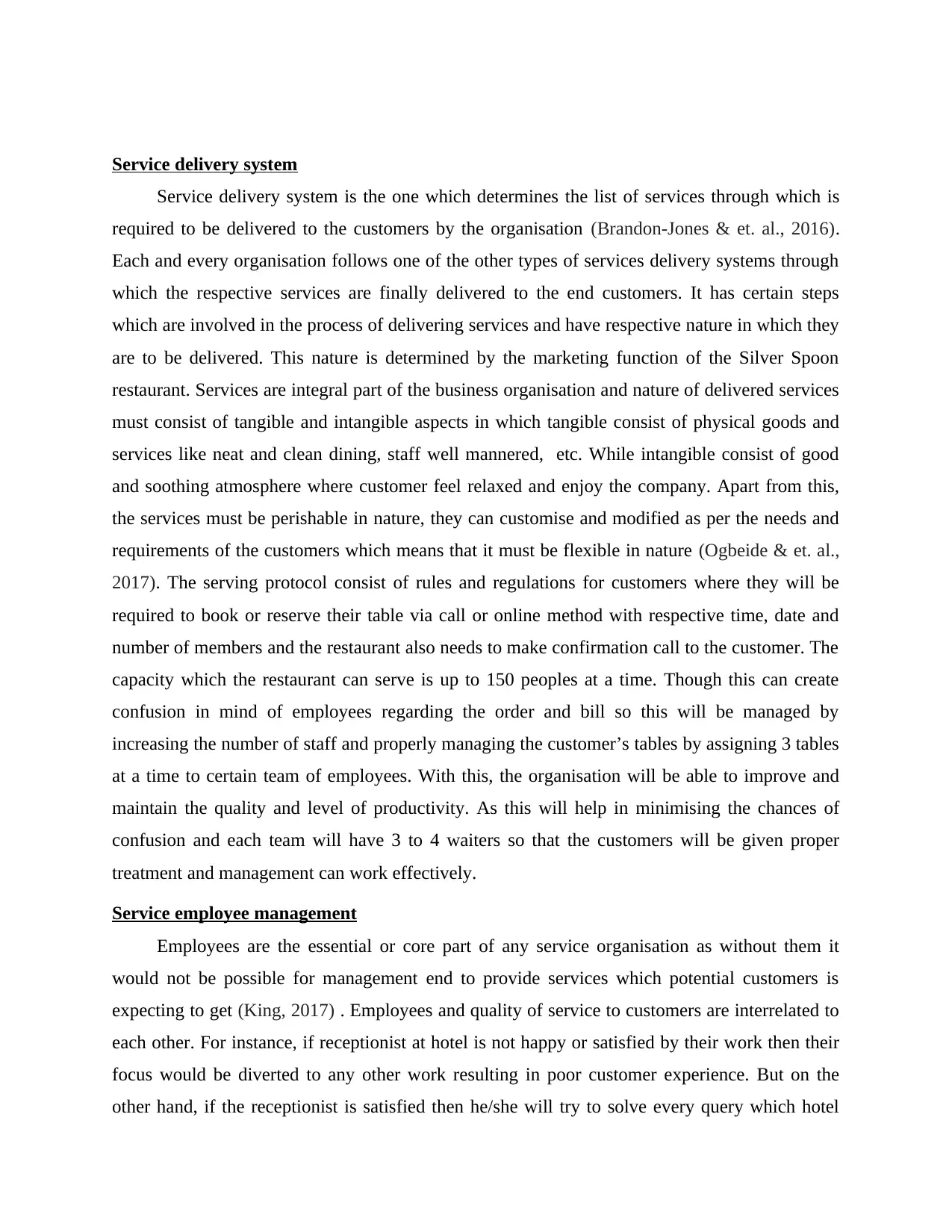
Service delivery system
Service delivery system is the one which determines the list of services through which is
required to be delivered to the customers by the organisation (Brandon-Jones & et. al., 2016).
Each and every organisation follows one of the other types of services delivery systems through
which the respective services are finally delivered to the end customers. It has certain steps
which are involved in the process of delivering services and have respective nature in which they
are to be delivered. This nature is determined by the marketing function of the Silver Spoon
restaurant. Services are integral part of the business organisation and nature of delivered services
must consist of tangible and intangible aspects in which tangible consist of physical goods and
services like neat and clean dining, staff well mannered, etc. While intangible consist of good
and soothing atmosphere where customer feel relaxed and enjoy the company. Apart from this,
the services must be perishable in nature, they can customise and modified as per the needs and
requirements of the customers which means that it must be flexible in nature (Ogbeide & et. al.,
2017). The serving protocol consist of rules and regulations for customers where they will be
required to book or reserve their table via call or online method with respective time, date and
number of members and the restaurant also needs to make confirmation call to the customer. The
capacity which the restaurant can serve is up to 150 peoples at a time. Though this can create
confusion in mind of employees regarding the order and bill so this will be managed by
increasing the number of staff and properly managing the customer’s tables by assigning 3 tables
at a time to certain team of employees. With this, the organisation will be able to improve and
maintain the quality and level of productivity. As this will help in minimising the chances of
confusion and each team will have 3 to 4 waiters so that the customers will be given proper
treatment and management can work effectively.
Service employee management
Employees are the essential or core part of any service organisation as without them it
would not be possible for management end to provide services which potential customers is
expecting to get (King, 2017) . Employees and quality of service to customers are interrelated to
each other. For instance, if receptionist at hotel is not happy or satisfied by their work then their
focus would be diverted to any other work resulting in poor customer experience. But on the
other hand, if the receptionist is satisfied then he/she will try to solve every query which hotel
Service delivery system is the one which determines the list of services through which is
required to be delivered to the customers by the organisation (Brandon-Jones & et. al., 2016).
Each and every organisation follows one of the other types of services delivery systems through
which the respective services are finally delivered to the end customers. It has certain steps
which are involved in the process of delivering services and have respective nature in which they
are to be delivered. This nature is determined by the marketing function of the Silver Spoon
restaurant. Services are integral part of the business organisation and nature of delivered services
must consist of tangible and intangible aspects in which tangible consist of physical goods and
services like neat and clean dining, staff well mannered, etc. While intangible consist of good
and soothing atmosphere where customer feel relaxed and enjoy the company. Apart from this,
the services must be perishable in nature, they can customise and modified as per the needs and
requirements of the customers which means that it must be flexible in nature (Ogbeide & et. al.,
2017). The serving protocol consist of rules and regulations for customers where they will be
required to book or reserve their table via call or online method with respective time, date and
number of members and the restaurant also needs to make confirmation call to the customer. The
capacity which the restaurant can serve is up to 150 peoples at a time. Though this can create
confusion in mind of employees regarding the order and bill so this will be managed by
increasing the number of staff and properly managing the customer’s tables by assigning 3 tables
at a time to certain team of employees. With this, the organisation will be able to improve and
maintain the quality and level of productivity. As this will help in minimising the chances of
confusion and each team will have 3 to 4 waiters so that the customers will be given proper
treatment and management can work effectively.
Service employee management
Employees are the essential or core part of any service organisation as without them it
would not be possible for management end to provide services which potential customers is
expecting to get (King, 2017) . Employees and quality of service to customers are interrelated to
each other. For instance, if receptionist at hotel is not happy or satisfied by their work then their
focus would be diverted to any other work resulting in poor customer experience. But on the
other hand, if the receptionist is satisfied then he/she will try to solve every query which hotel
Paraphrase This Document
Need a fresh take? Get an instant paraphrase of this document with our AI Paraphraser
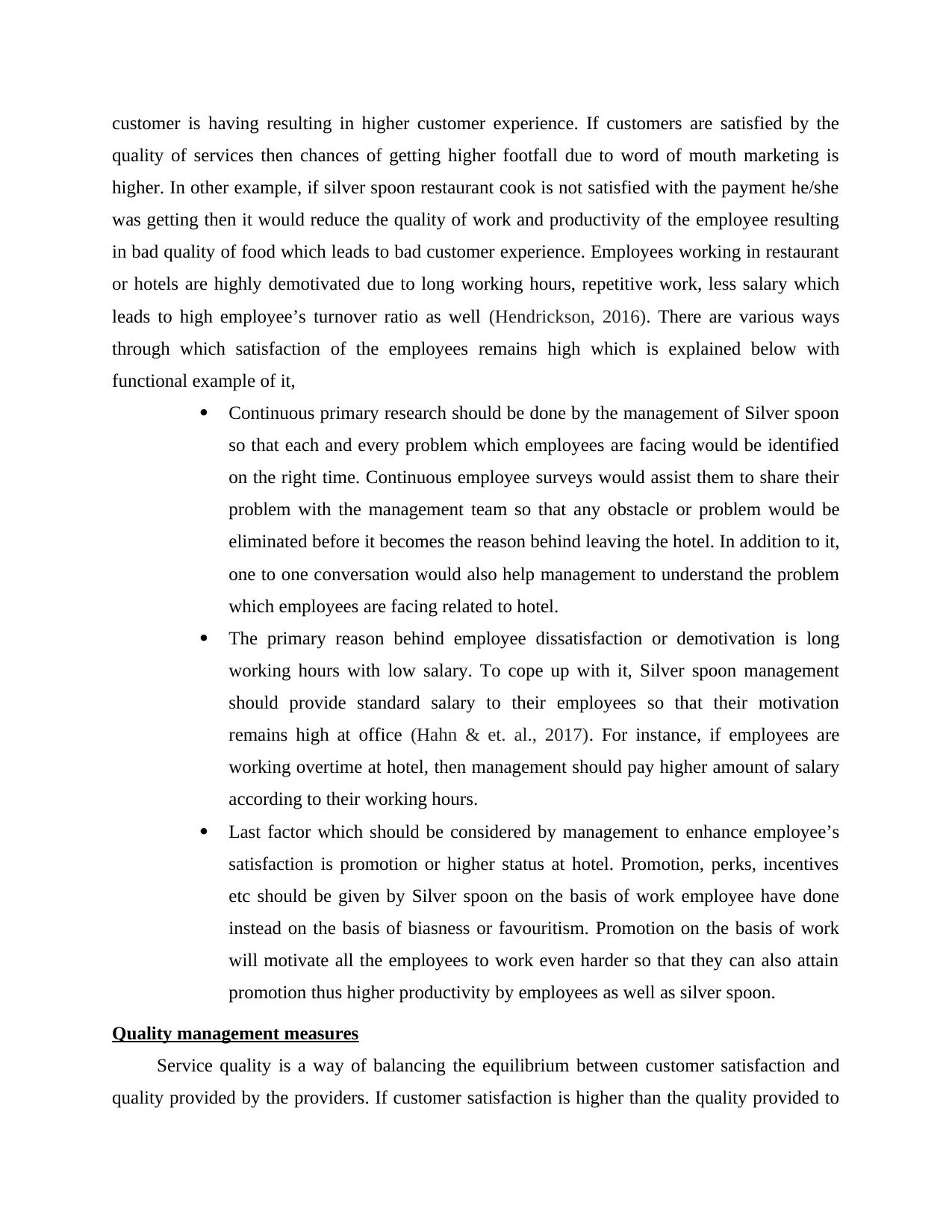
customer is having resulting in higher customer experience. If customers are satisfied by the
quality of services then chances of getting higher footfall due to word of mouth marketing is
higher. In other example, if silver spoon restaurant cook is not satisfied with the payment he/she
was getting then it would reduce the quality of work and productivity of the employee resulting
in bad quality of food which leads to bad customer experience. Employees working in restaurant
or hotels are highly demotivated due to long working hours, repetitive work, less salary which
leads to high employee’s turnover ratio as well (Hendrickson, 2016). There are various ways
through which satisfaction of the employees remains high which is explained below with
functional example of it,
Continuous primary research should be done by the management of Silver spoon
so that each and every problem which employees are facing would be identified
on the right time. Continuous employee surveys would assist them to share their
problem with the management team so that any obstacle or problem would be
eliminated before it becomes the reason behind leaving the hotel. In addition to it,
one to one conversation would also help management to understand the problem
which employees are facing related to hotel.
The primary reason behind employee dissatisfaction or demotivation is long
working hours with low salary. To cope up with it, Silver spoon management
should provide standard salary to their employees so that their motivation
remains high at office (Hahn & et. al., 2017). For instance, if employees are
working overtime at hotel, then management should pay higher amount of salary
according to their working hours.
Last factor which should be considered by management to enhance employee’s
satisfaction is promotion or higher status at hotel. Promotion, perks, incentives
etc should be given by Silver spoon on the basis of work employee have done
instead on the basis of biasness or favouritism. Promotion on the basis of work
will motivate all the employees to work even harder so that they can also attain
promotion thus higher productivity by employees as well as silver spoon.
Quality management measures
Service quality is a way of balancing the equilibrium between customer satisfaction and
quality provided by the providers. If customer satisfaction is higher than the quality provided to
quality of services then chances of getting higher footfall due to word of mouth marketing is
higher. In other example, if silver spoon restaurant cook is not satisfied with the payment he/she
was getting then it would reduce the quality of work and productivity of the employee resulting
in bad quality of food which leads to bad customer experience. Employees working in restaurant
or hotels are highly demotivated due to long working hours, repetitive work, less salary which
leads to high employee’s turnover ratio as well (Hendrickson, 2016). There are various ways
through which satisfaction of the employees remains high which is explained below with
functional example of it,
Continuous primary research should be done by the management of Silver spoon
so that each and every problem which employees are facing would be identified
on the right time. Continuous employee surveys would assist them to share their
problem with the management team so that any obstacle or problem would be
eliminated before it becomes the reason behind leaving the hotel. In addition to it,
one to one conversation would also help management to understand the problem
which employees are facing related to hotel.
The primary reason behind employee dissatisfaction or demotivation is long
working hours with low salary. To cope up with it, Silver spoon management
should provide standard salary to their employees so that their motivation
remains high at office (Hahn & et. al., 2017). For instance, if employees are
working overtime at hotel, then management should pay higher amount of salary
according to their working hours.
Last factor which should be considered by management to enhance employee’s
satisfaction is promotion or higher status at hotel. Promotion, perks, incentives
etc should be given by Silver spoon on the basis of work employee have done
instead on the basis of biasness or favouritism. Promotion on the basis of work
will motivate all the employees to work even harder so that they can also attain
promotion thus higher productivity by employees as well as silver spoon.
Quality management measures
Service quality is a way of balancing the equilibrium between customer satisfaction and
quality provided by the providers. If customer satisfaction is higher than the quality provided to
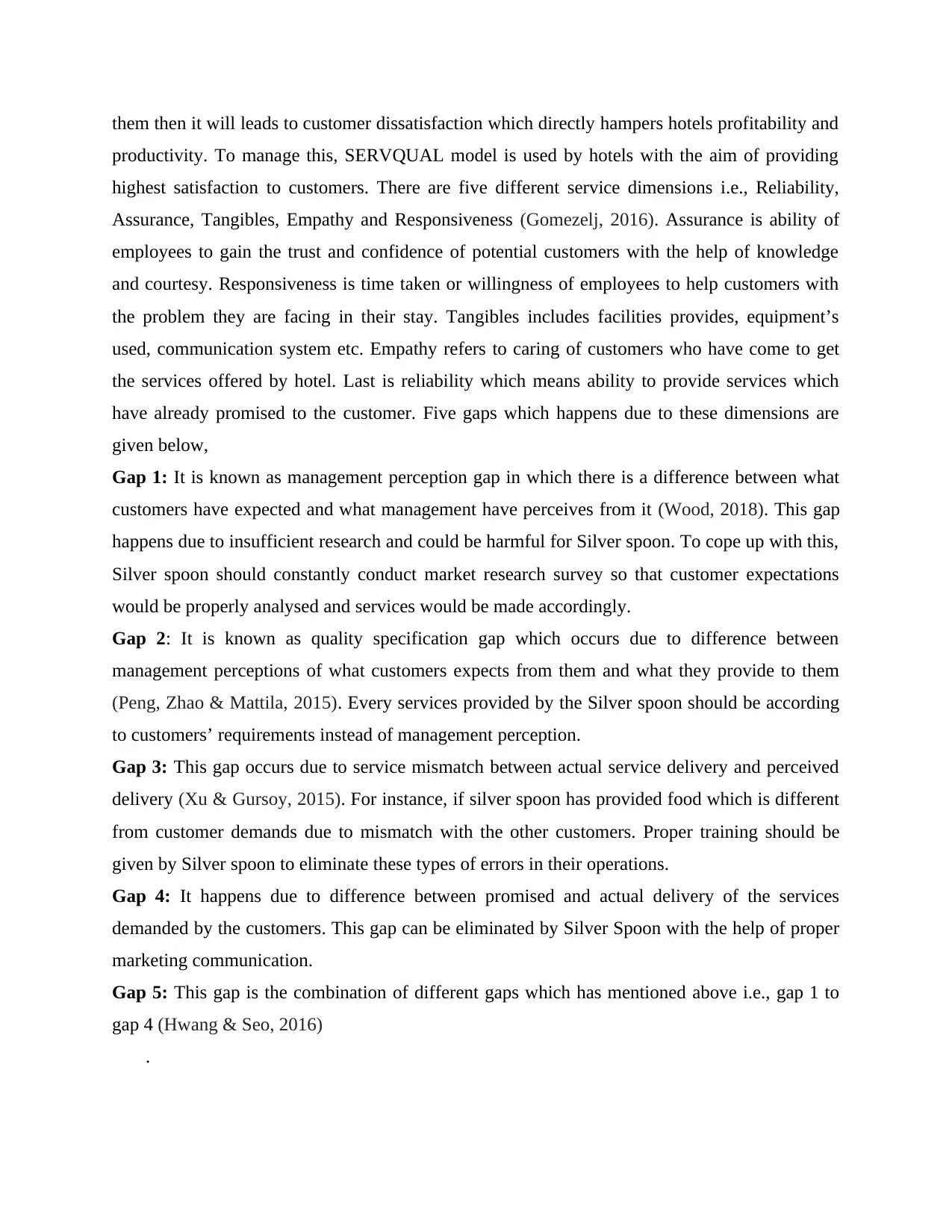
them then it will leads to customer dissatisfaction which directly hampers hotels profitability and
productivity. To manage this, SERVQUAL model is used by hotels with the aim of providing
highest satisfaction to customers. There are five different service dimensions i.e., Reliability,
Assurance, Tangibles, Empathy and Responsiveness (Gomezelj, 2016). Assurance is ability of
employees to gain the trust and confidence of potential customers with the help of knowledge
and courtesy. Responsiveness is time taken or willingness of employees to help customers with
the problem they are facing in their stay. Tangibles includes facilities provides, equipment’s
used, communication system etc. Empathy refers to caring of customers who have come to get
the services offered by hotel. Last is reliability which means ability to provide services which
have already promised to the customer. Five gaps which happens due to these dimensions are
given below,
Gap 1: It is known as management perception gap in which there is a difference between what
customers have expected and what management have perceives from it (Wood, 2018). This gap
happens due to insufficient research and could be harmful for Silver spoon. To cope up with this,
Silver spoon should constantly conduct market research survey so that customer expectations
would be properly analysed and services would be made accordingly.
Gap 2: It is known as quality specification gap which occurs due to difference between
management perceptions of what customers expects from them and what they provide to them
(Peng, Zhao & Mattila, 2015). Every services provided by the Silver spoon should be according
to customers’ requirements instead of management perception.
Gap 3: This gap occurs due to service mismatch between actual service delivery and perceived
delivery (Xu & Gursoy, 2015). For instance, if silver spoon has provided food which is different
from customer demands due to mismatch with the other customers. Proper training should be
given by Silver spoon to eliminate these types of errors in their operations.
Gap 4: It happens due to difference between promised and actual delivery of the services
demanded by the customers. This gap can be eliminated by Silver Spoon with the help of proper
marketing communication.
Gap 5: This gap is the combination of different gaps which has mentioned above i.e., gap 1 to
gap 4 (Hwang & Seo, 2016)
.
productivity. To manage this, SERVQUAL model is used by hotels with the aim of providing
highest satisfaction to customers. There are five different service dimensions i.e., Reliability,
Assurance, Tangibles, Empathy and Responsiveness (Gomezelj, 2016). Assurance is ability of
employees to gain the trust and confidence of potential customers with the help of knowledge
and courtesy. Responsiveness is time taken or willingness of employees to help customers with
the problem they are facing in their stay. Tangibles includes facilities provides, equipment’s
used, communication system etc. Empathy refers to caring of customers who have come to get
the services offered by hotel. Last is reliability which means ability to provide services which
have already promised to the customer. Five gaps which happens due to these dimensions are
given below,
Gap 1: It is known as management perception gap in which there is a difference between what
customers have expected and what management have perceives from it (Wood, 2018). This gap
happens due to insufficient research and could be harmful for Silver spoon. To cope up with this,
Silver spoon should constantly conduct market research survey so that customer expectations
would be properly analysed and services would be made accordingly.
Gap 2: It is known as quality specification gap which occurs due to difference between
management perceptions of what customers expects from them and what they provide to them
(Peng, Zhao & Mattila, 2015). Every services provided by the Silver spoon should be according
to customers’ requirements instead of management perception.
Gap 3: This gap occurs due to service mismatch between actual service delivery and perceived
delivery (Xu & Gursoy, 2015). For instance, if silver spoon has provided food which is different
from customer demands due to mismatch with the other customers. Proper training should be
given by Silver spoon to eliminate these types of errors in their operations.
Gap 4: It happens due to difference between promised and actual delivery of the services
demanded by the customers. This gap can be eliminated by Silver Spoon with the help of proper
marketing communication.
Gap 5: This gap is the combination of different gaps which has mentioned above i.e., gap 1 to
gap 4 (Hwang & Seo, 2016)
.
⊘ This is a preview!⊘
Do you want full access?
Subscribe today to unlock all pages.

Trusted by 1+ million students worldwide
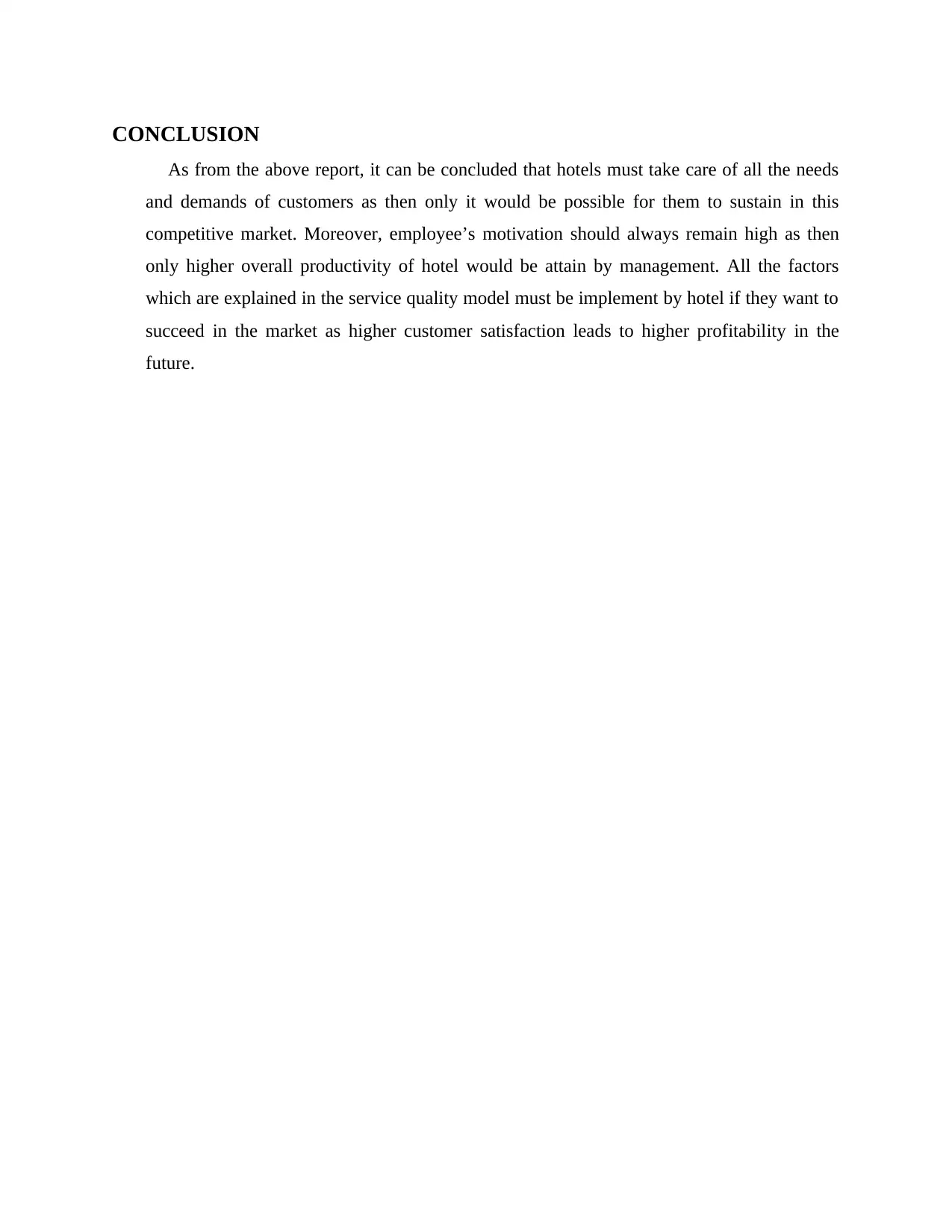
CONCLUSION
As from the above report, it can be concluded that hotels must take care of all the needs
and demands of customers as then only it would be possible for them to sustain in this
competitive market. Moreover, employee’s motivation should always remain high as then
only higher overall productivity of hotel would be attain by management. All the factors
which are explained in the service quality model must be implement by hotel if they want to
succeed in the market as higher customer satisfaction leads to higher profitability in the
future.
As from the above report, it can be concluded that hotels must take care of all the needs
and demands of customers as then only it would be possible for them to sustain in this
competitive market. Moreover, employee’s motivation should always remain high as then
only higher overall productivity of hotel would be attain by management. All the factors
which are explained in the service quality model must be implement by hotel if they want to
succeed in the market as higher customer satisfaction leads to higher profitability in the
future.
Paraphrase This Document
Need a fresh take? Get an instant paraphrase of this document with our AI Paraphraser
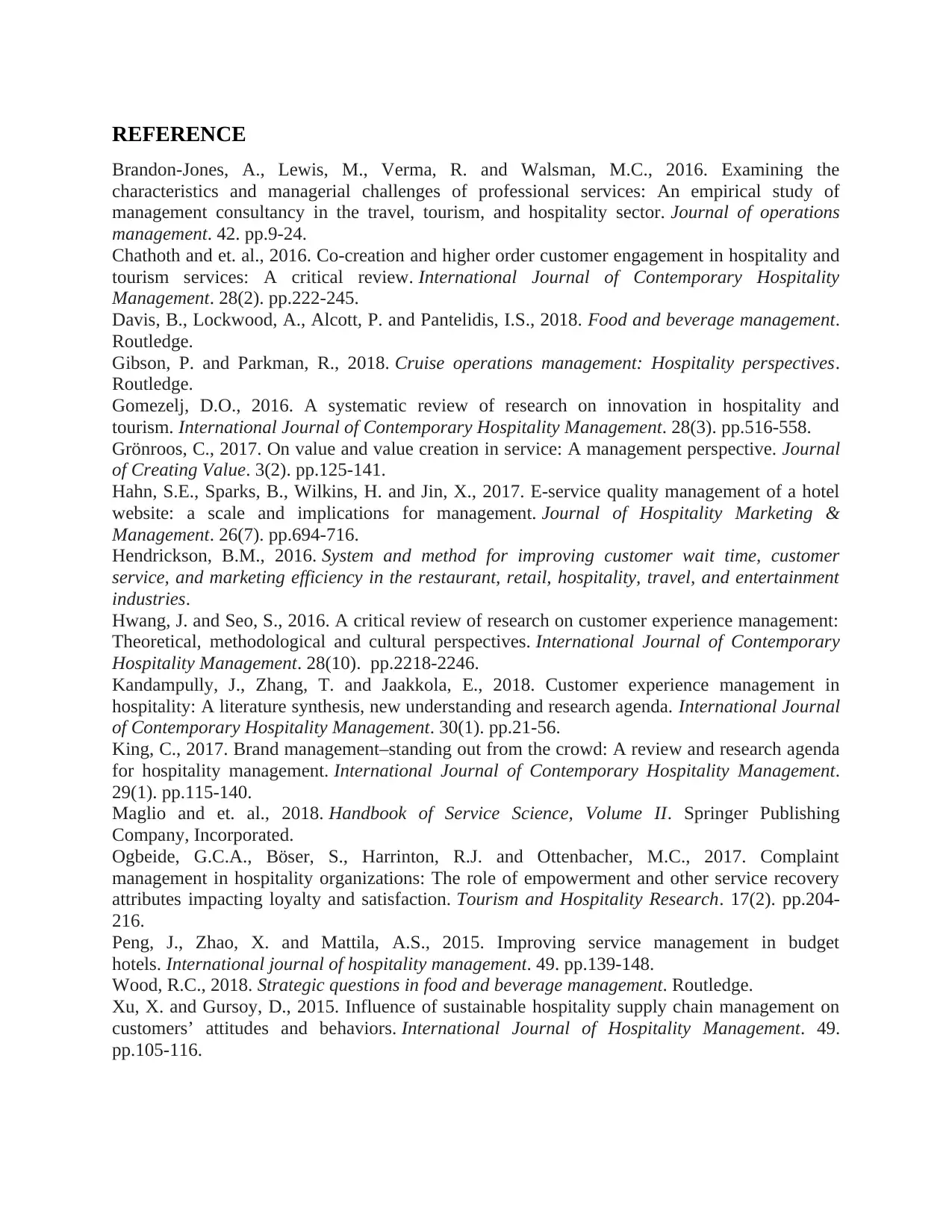
REFERENCE
Brandon-Jones, A., Lewis, M., Verma, R. and Walsman, M.C., 2016. Examining the
characteristics and managerial challenges of professional services: An empirical study of
management consultancy in the travel, tourism, and hospitality sector. Journal of operations
management. 42. pp.9-24.
Chathoth and et. al., 2016. Co-creation and higher order customer engagement in hospitality and
tourism services: A critical review. International Journal of Contemporary Hospitality
Management. 28(2). pp.222-245.
Davis, B., Lockwood, A., Alcott, P. and Pantelidis, I.S., 2018. Food and beverage management.
Routledge.
Gibson, P. and Parkman, R., 2018. Cruise operations management: Hospitality perspectives.
Routledge.
Gomezelj, D.O., 2016. A systematic review of research on innovation in hospitality and
tourism. International Journal of Contemporary Hospitality Management. 28(3). pp.516-558.
Grönroos, C., 2017. On value and value creation in service: A management perspective. Journal
of Creating Value. 3(2). pp.125-141.
Hahn, S.E., Sparks, B., Wilkins, H. and Jin, X., 2017. E-service quality management of a hotel
website: a scale and implications for management. Journal of Hospitality Marketing &
Management. 26(7). pp.694-716.
Hendrickson, B.M., 2016. System and method for improving customer wait time, customer
service, and marketing efficiency in the restaurant, retail, hospitality, travel, and entertainment
industries.
Hwang, J. and Seo, S., 2016. A critical review of research on customer experience management:
Theoretical, methodological and cultural perspectives. International Journal of Contemporary
Hospitality Management. 28(10). pp.2218-2246.
Kandampully, J., Zhang, T. and Jaakkola, E., 2018. Customer experience management in
hospitality: A literature synthesis, new understanding and research agenda. International Journal
of Contemporary Hospitality Management. 30(1). pp.21-56.
King, C., 2017. Brand management–standing out from the crowd: A review and research agenda
for hospitality management. International Journal of Contemporary Hospitality Management.
29(1). pp.115-140.
Maglio and et. al., 2018. Handbook of Service Science, Volume II. Springer Publishing
Company, Incorporated.
Ogbeide, G.C.A., Böser, S., Harrinton, R.J. and Ottenbacher, M.C., 2017. Complaint
management in hospitality organizations: The role of empowerment and other service recovery
attributes impacting loyalty and satisfaction. Tourism and Hospitality Research. 17(2). pp.204-
216.
Peng, J., Zhao, X. and Mattila, A.S., 2015. Improving service management in budget
hotels. International journal of hospitality management. 49. pp.139-148.
Wood, R.C., 2018. Strategic questions in food and beverage management. Routledge.
Xu, X. and Gursoy, D., 2015. Influence of sustainable hospitality supply chain management on
customers’ attitudes and behaviors. International Journal of Hospitality Management. 49.
pp.105-116.
Brandon-Jones, A., Lewis, M., Verma, R. and Walsman, M.C., 2016. Examining the
characteristics and managerial challenges of professional services: An empirical study of
management consultancy in the travel, tourism, and hospitality sector. Journal of operations
management. 42. pp.9-24.
Chathoth and et. al., 2016. Co-creation and higher order customer engagement in hospitality and
tourism services: A critical review. International Journal of Contemporary Hospitality
Management. 28(2). pp.222-245.
Davis, B., Lockwood, A., Alcott, P. and Pantelidis, I.S., 2018. Food and beverage management.
Routledge.
Gibson, P. and Parkman, R., 2018. Cruise operations management: Hospitality perspectives.
Routledge.
Gomezelj, D.O., 2016. A systematic review of research on innovation in hospitality and
tourism. International Journal of Contemporary Hospitality Management. 28(3). pp.516-558.
Grönroos, C., 2017. On value and value creation in service: A management perspective. Journal
of Creating Value. 3(2). pp.125-141.
Hahn, S.E., Sparks, B., Wilkins, H. and Jin, X., 2017. E-service quality management of a hotel
website: a scale and implications for management. Journal of Hospitality Marketing &
Management. 26(7). pp.694-716.
Hendrickson, B.M., 2016. System and method for improving customer wait time, customer
service, and marketing efficiency in the restaurant, retail, hospitality, travel, and entertainment
industries.
Hwang, J. and Seo, S., 2016. A critical review of research on customer experience management:
Theoretical, methodological and cultural perspectives. International Journal of Contemporary
Hospitality Management. 28(10). pp.2218-2246.
Kandampully, J., Zhang, T. and Jaakkola, E., 2018. Customer experience management in
hospitality: A literature synthesis, new understanding and research agenda. International Journal
of Contemporary Hospitality Management. 30(1). pp.21-56.
King, C., 2017. Brand management–standing out from the crowd: A review and research agenda
for hospitality management. International Journal of Contemporary Hospitality Management.
29(1). pp.115-140.
Maglio and et. al., 2018. Handbook of Service Science, Volume II. Springer Publishing
Company, Incorporated.
Ogbeide, G.C.A., Böser, S., Harrinton, R.J. and Ottenbacher, M.C., 2017. Complaint
management in hospitality organizations: The role of empowerment and other service recovery
attributes impacting loyalty and satisfaction. Tourism and Hospitality Research. 17(2). pp.204-
216.
Peng, J., Zhao, X. and Mattila, A.S., 2015. Improving service management in budget
hotels. International journal of hospitality management. 49. pp.139-148.
Wood, R.C., 2018. Strategic questions in food and beverage management. Routledge.
Xu, X. and Gursoy, D., 2015. Influence of sustainable hospitality supply chain management on
customers’ attitudes and behaviors. International Journal of Hospitality Management. 49.
pp.105-116.
1 out of 11
Related Documents
Your All-in-One AI-Powered Toolkit for Academic Success.
+13062052269
info@desklib.com
Available 24*7 on WhatsApp / Email
![[object Object]](/_next/static/media/star-bottom.7253800d.svg)
Unlock your academic potential
Copyright © 2020–2025 A2Z Services. All Rights Reserved. Developed and managed by ZUCOL.





